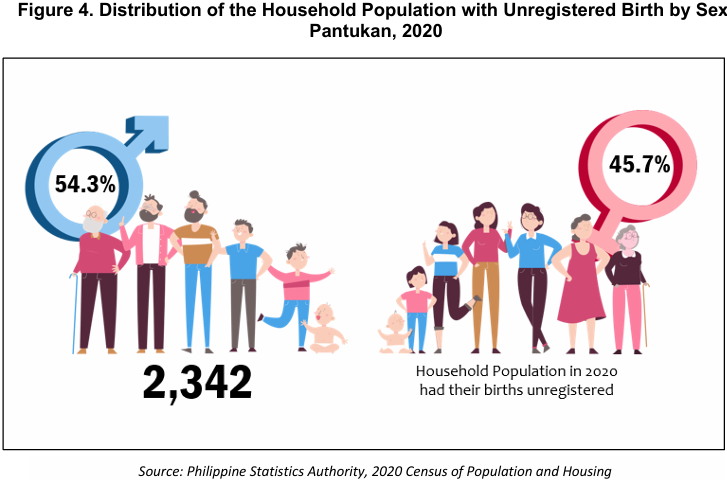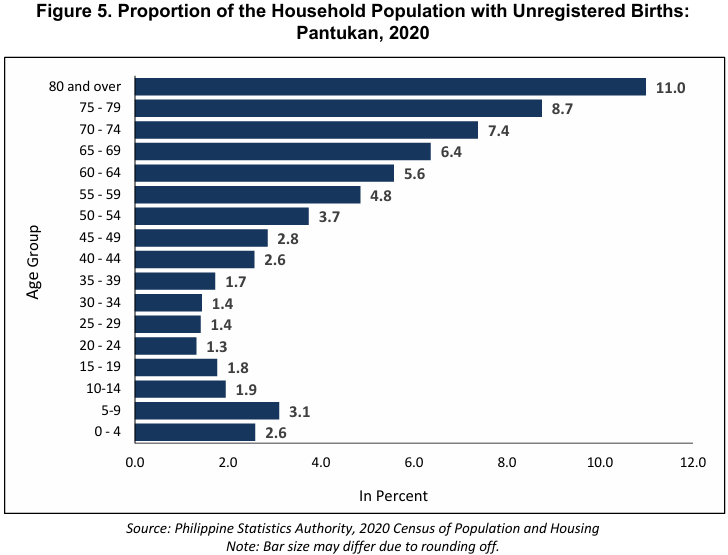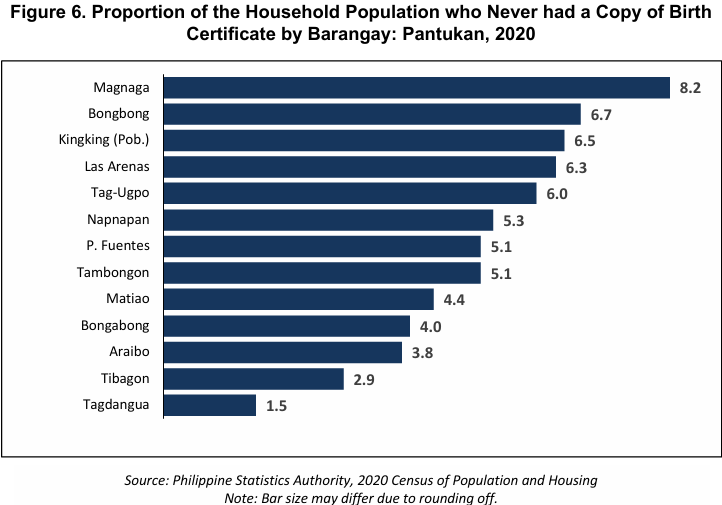Proportion of persons with unregistered births in Pantukan decreases to 2.6 percent
The 2020 Census of Population and Housing (2020 CPH) revealed that a total of 2,342 persons of the household population in 2020 had their births unregistered with the Local Civil Registry Office (LCRO) of Pantukan. This is equivalent to 2.6 percent of the 90,747 household population in 2020.(Figure 1)
Moreover, census results from 2015 to 2020 show a decreasing trend in the proportion of persons with unregistered births, from 5.0 percent to 2.6 percent in 2020. The 2020 figure is lower by 2.4 percentage points. (Figure 1)

Pantukan is 2nd lowest in the proportion of persons with unregistered births
In 2020, Davao de Oro reported a 3.6 percent of the household population whose births were unregistered with the LCROs. At the municipal level, Monkayo posted the highest with 5.5 percent of the household population. This was followed by Mabini with 4.9 percent and New Bataan with 4.5 percent. (Figure 2)
Two other municipalities posted a proportion higher than the provincial level, namely, Laak and Mawab. (Figure 2)

On the other hand, Nabunturan posted the lowest proportion of persons with unregistered births (2.4%). Ranked second lowest in the proportion is Pantukan at 2.6 percent translating to 2,342 of the total household population. (Figure 2)
Proportion of persons with unregistered births is highest in Kingking (Poblacion); lowest in Tagdangua
Among the 13 barangays, Kingking (Poblacion) posted the highest proportion of the household population whose births were reported to be unregistered at 3.2 percent, corresponding to 940 persons out of the 29,286 household population in the barangay. It was followed by P. Fuentes with 3.0 percent (119 persons), and Napnapan with 2.9 percent (363 persons). (Table 1 and Figure 3)

Meanwhile, Tagdangua recorded the lowest proportion of unregistered births at 0.7 percent, followed by Tibagon (1.4%), and Bongabong and Las Arenas (both at 1.7%). (Table 1 and Figure 3)

More males than females have unregistered births
Among the 2,342 household population whose births were unregistered with the LCRO, 54.3 percent (1,271) were males, while 45.7 percent (1,071) were females. This translates to a sex ratio of 119 males whose births were unregistered with the LCRO for every 100 females whose births were also unregistered. (Figure 4)
At the barangay level, Kingking (Poblacion) which had the highest proportion whose births were unregistered with the LCRO, also showed a higher percentage of males at 56.0 percent compared to females at 44.0 percent.

The oldest age groups post the highest proportions of unregistered births
Across age groups, the household population aged 80 years and over had the highest proportion of unregistered births at 11.0 percent. The high proportion was also noted in the age group 75-79 years (8.7%), followed by those in the age groups 70-74 years (7.4%), 65-69 years (6.4%), and 60-64 years (5.6%). (Figure 5)
In contrast, the lowest proportion was recorded among age groups 20-24 years at 1.3 percent, and 25-29 years and 30-34 years both at 1.4 percent. (Figure 5)
In addition, about 6.8 percent, or 429 persons out of 6,297 aged 60 years and above were reported in the census to have unregistered births. This means that about seven (7) in 100 senior citizens have unregistered births. (Figure 5)

Magnaga posts the highest proportion of persons who never had a copy of their birth certificates
While 2.6 percent of the household population revealed that their births were unregistered, about 5.6 percent reported that they never had a copy of their birth certificates. A total of 5,119 persons of the 90,747 household population were reported to never had a copy of their birth certificates. (Table 2 and Figure 6)
Among the 13 barangays, Magnaga recorded the highest proportion of the household population who never had a copy of their birth certificates, 8.2 percent or 879 persons. It was followed by Bongbong (6.7%), Kingking (Poblacion) (6.5%), and Las Arenas (6.3%). (Table 2 and Figure 6)

On the other hand, Tagdangua posted the lowest proportion of persons who never had a copy of their birth certificates at 1.5 percent, followed by Tibagon at 2.9 percent, and Araibo at 3.8 percent. (Table 2 and Figure 6)

TECHNICAL NOTES
The statistics presented in this Special Release were based on the answers and information provided by the respondent or any responsible member of the household to the questions on birth registration about all the household members. For the 2020 CPH, birth registration data of all household members were collected by asking the respondents, “Was ______’s birth registered with the Local Civil Registry Office?” and “Has _____ ever had a copy of his/her birth certificate?”
